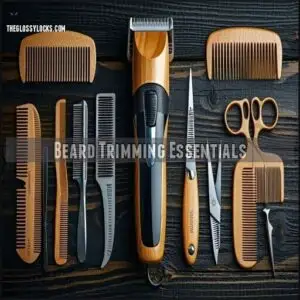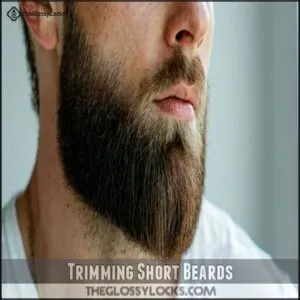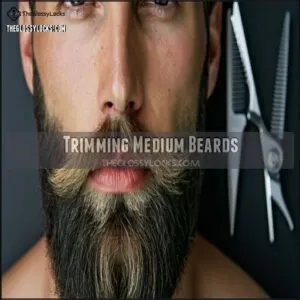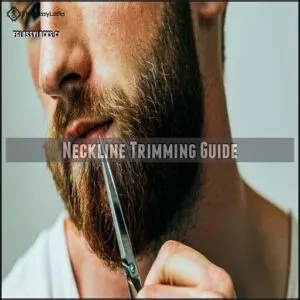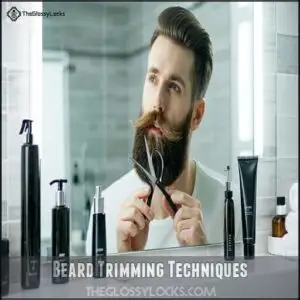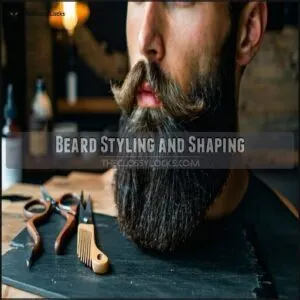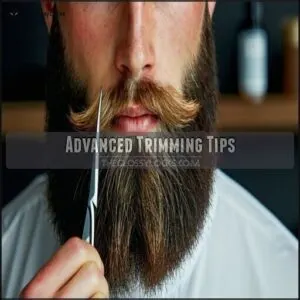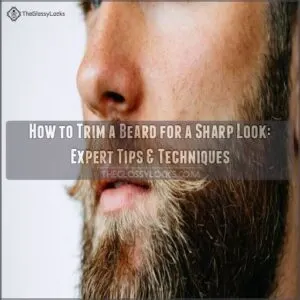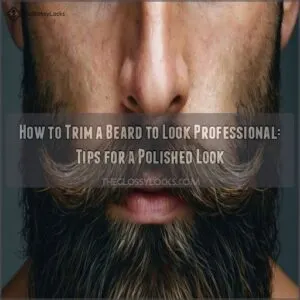This site is supported by our readers. We may earn a commission, at no cost to you, if you purchase through links.
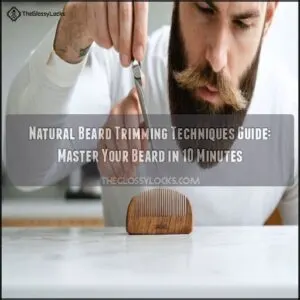 Mastering natural beard trimming techniques is simpler than you think. Start by picking quality tools—a sharp trimmer, scissors, and a beard comb make all the difference.
Mastering natural beard trimming techniques is simpler than you think. Start by picking quality tools—a sharp trimmer, scissors, and a beard comb make all the difference.
Brush your beard to detangle and spot uneven areas. Trim with the grain for a smooth, natural look, and use scissors for precision on stray hairs.
Define your neckline by imagining a soft curve below your jaw, and shape cheek lines for symmetry. For longer beards, trim in stages to maintain volume while creating shape.
A little patience and practice go a long way. Want a pro finish? There’s more to explore in shaping secrets!
Table Of Contents
Key Takeaways
- Brush your beard and trim with the grain for a smooth, natural look, and use scissors for precise stray hair removal.
- Define your neckline and cheeklines carefully for symmetry and a polished appearance.
- Use beard oil, a quality trimmer, and scissors to maintain healthy growth and precise shaping.
- Regular grooming, blending different lengths, and trimming small sections ensure a well-groomed, balanced beard.
Beard Trimming Essentials
You’ll need the right tools to transform your beard from scruffy to sculpted, including a quality trimmer, sharp scissors, and proper combs.
A well-equipped grooming arsenal guarantees precision and control, letting you shape your beard with confidence in just minutes.
Necessary Tools and Equipment
Every great beard starts with the right tools.
Essential beard trimming tools include:
- Beard Trimming Scissors: Keep scissor sharpness high for precision snips.
- Electric Clippers: Perfect for defining lines and managing bulk.
- Beard Comb and Brush: Choose durable comb material to detangle and align hairs.
- Mirror Setup: Thoughtful mirror placement guarantees clean cuts from all angles.
Consider scissor product options for superior results.
Proper gear simplifies trimming!
Importance of High-Quality Trimmers
Investing in a high-quality trimmer transforms your beard game completely.
These precision cutting tools handle various hair textures without causing skin irritation, ensuring an even trim every time.
With superior blade material and motor durability, they’re a long-term investment that prevents nicks and maintains healthy skin beneath your beard.
Consider professional grade options for enhanced performance.
Unlike cheap alternatives, quality trimmers give you the control needed to master advanced beard trimming techniques without frustration, making them a worthwhile investment for a healthy skin.
Beard Brush and Comb Usage
Behind every well-groomed beard stands a quality brush and comb.
You’ll need both for different purposes—your beard brush (preferably with boar bristles) trains growth direction and distributes product evenly, while a wide-tooth beard comb tackles detangling.
The comb material matters too; wooden combs prevent static.
Master the detangling technique by working from tips to roots, and you’ll maintain your beard’s health between trims.
Trimming Short Beards
You’ll master short beard trimming by focusing on clean necklines, defined cheek lines, and mustache boundaries within just a few minutes.
Your well-groomed short beard requires minimal effort but maximum attention to these key areas, creating that perfect shape that frames your face naturally, with well-groomed being essential to the overall look.
Establishing Neckline and Cheek Lines
Now that you have your tools ready, let’s establish your beard boundaries. A proper neckline creates the foundation for your short beard.
Picture a U-shaped line connecting your ears and crossing about two fingers above your Adam’s apple. For cheek lines, imagine a natural curve from your sideburns to your mustache corner.
Remember, these facial hair boundaries determine your beard’s overall shape harmony. To maintain this look, schedule regular trims every 1-2 weeks, which is crucial for a well-groomed short beard and to achieve a natural curve.
Trimming Mustache and Stray Hairs
With your neckline and cheek lines set, it’s time to tackle those unruly mustache hairs and flyaways. Grab your trimming scissors for precision work on your short beard.
Your mustache needs special attention—those hairs that creep over your lip can be both annoying and messy.
- Use scissors for mustache trimming, not clippers for better control
- Comb mustache downward to identify strays before snipping
- Focus on symmetry by trimming small amounts from both sides
- Remove flyaways by snipping perpendicular to growth direction
- Blend mustache corners into your beard for a cohesive look
Maintaining Short Beard Shape
Now that those stray hairs are tamed, let’s focus on keeping your short beard looking sharp.
Daily grooming maintains consistent length and symmetry—your best friends for a natural look. Check for symmetry each morning using a handheld mirror.
Apply beard oil before styling for healthier growth. Create tapered edges along your jawline for definition.
Remember, a well-maintained short beard trim isn’t about perfection—it’s about intentional beard shaping techniques that complement your face.
Trimming Medium Beards
You’ll need a steady hand and sharp tools to shape your medium beard into a masterpiece that frames your face perfectly.
With the right technique, you can transform that wild growth into a well-defined beard that balances your features while still maintaining its natural character, which is crucial for creating a look that balances your features.
Preparing for Trimming
Your medium beard requires three essential prep steps before trimming begins.
First, verify thorough beard washing with proper shampoo to remove dirt and oils.
Next, practice comb detangling from the ends working upward to minimize breakage.
Finally, apply a light beard oil to soften hair and consider tool sanitation and mirror placement for ideal visibility.
Beard oil softens whiskers, making them more manageable during shaping.
This preparation guarantees an even, precise trim without unexpected snags or patches, ensuring a successful trimming experience with the right preparation.
Removing Bulk From Cheeks
Now that your beard is properly prepared, let’s tackle those bushy cheeks. Removing excess bulk from your cheeks defines your jawline and prevents that unruly "mushroom beard" look.
Follow these 5 steps for perfect cheek trimming:
- Comb hair outward to identify dense areas
- Use a longer guard setting initially to maintain symmetry
- Go against the grain for more efficient bulk removal
- Gradually decrease guard length for desired cheek hair density
- Blend edges using natural beard trimming techniques
Trimming for Definition and Shape
Now that you’ve thinned the cheeks, it’s time to create that sharp definition.
Trim perpendicular to your jawline to enhance your face shape and create style harmony. Use your comb as a symmetry guide while trimming in short, gentle strokes.
This technique stimulates growth and creates clean beard trimming lines. When in doubt, seek barber consultation—they’ll teach you beard shaping tips that’ll give your medium beard perfect definition.
Trimming Long Beards
You’ll need steady hands and sharp scissors to tame your magnificent mane without losing the length you’ve worked so hard to grow.
With the right technique, you can shape your long beard to complement your face while removing just enough bulk to keep it looking intentional rather than neglected, which requires a delicate balance to achieve a well-groomed appearance with sharp scissors.
Trimming Techniques for Length
The key to maintaining length while trimming a long beard lies in proper technique and tools.
When tackling those magnificent facial locks, remember these essential steps:
- Use beard scissors to snip away longer stray hairs without compromising overall length
- Work downwards with the grain to preserve your hard-earned growth
- Keep the area between your neckline and Adam’s apple neat with an electric shaver
- Use a wide-tooth pick for gentle detangling with minimal tension
These steps are crucial for maintaining a well-groomed beard, and following them will help you achieve a neat and tidy look while preserving the length of your beard, which is often the result of hard-earned growth.
Maintaining Healthy and Shaped Beard
Once you’ve perfected your beard’s length, maintaining its health and shape becomes your daily mission.
Keep your natural beard looking its best by working with your growth patterns, not against them.
Apply beard oil after showering when follicles are open.
Regular trimming (just a snip here and there) preserves your style while allowing continued growth.
Remember, consistent shaping and lifestyle factors like diet and hydration directly impact your beard’s overall appearance.
Avoiding Common Mistakes
While maintaining your beard’s health is essential, watching out for common pitfalls can save you from beard disasters.
When trimming your long beard, avoid these beard trimming mistakes:
- Over-trimming in a single session (step away and reassess tomorrow)
- Creating harsh lines instead of natural-looking edges
- Neglecting patchy areas that need special attention
Uneven sides often result from rushing or poor lighting. Take your time—your magnificent beard deserves those extra minutes!
Neckline Trimming Guide
Getting your neckline right is the key to a well-groomed beard that frames your face.
By defining it just above the Adam’s apple and trimming carefully, you’ll avoid the "floating beard" look.
Defining The Neckline
Finding the perfect neckline is your beard’s foundation.
Locate it just above your Adam’s apple where your head meets your neck—about two finger-widths above.
For a boxed look, create clean, straight edges; for a rounded appearance, aim for a gentle U-shape.
A good starting point is to locate your neckline by placing two fingers above your Adam’s apple.
Make a gradual shift by using different guard lengths, avoiding the common mistake of trimming too high on your jawline.
Trimming The Under Beard
Many beardsmen overlook the under beard area, which is essential for a polished look.
Use the hedge method to trim scraggly hairs beneath your chin, creating a clean silhouette.
For a boxed beard, maintain a straight line from tip to back corners.
If you prefer a rounded beard, gently blend the shape for a softer appearance.
Always avoid trimming at the jawline itself.
Creating a Natural Look
A natural-looking neckline transforms your entire beard game.
Create gradual shifts by using a slightly longer trimmer setting where your neck meets your beard. Blend different lengths for a softer appearance instead of harsh lines.
Embrace slight uneven growth—perfect symmetry often looks artificial.
When softening edges, work in small sections and step back frequently to check natural beard balance. You’ll achieve that "I woke up this handsome" look with minimal effort.
Cheek Line Trimming
You’ll need to define your cheek line to frame your face properly and create that polished beard look.
With your electric clippers or razor, trim along your natural cheek line or slightly below it for a clean edge that complements your face shape.
Finding The Right Cheek Line
Now that you’ve mastered your neckline, let’s determine your ideal cheek line. The perfect cheek line balances your face shape and natural growth patterns.
Try the "imaginary line" rule—visualize a path from your mouth corner to mid-ear.
Before defining your beard trimming lines, let your facial hair grow naturally for a while. This reveals your unique growth pattern and helps you decide between a high cheekline, low cheekline, or natural cheekline.
Trimming for Symmetry
You’ll notice that achieving beard symmetry isn’t just aesthetically pleasing—it’s essential for balancing facial features.
Start by using your comb as a guide to check if both beard sides match. When trimming, work slowly and deliberately, making small adjustments rather than large cuts.
If you spot asymmetry, don’t panic! Professional beard trimming techniques involve correcting one side at a time until your beard shape appears even.
Maintaining Cheek Line Shape
Once you’ve established your perfect cheek line, maintaining it requires weekly attention to prevent a wild, unkempt appearance.
Check both sides regularly for symmetry techniques and natural lines.
- Use a trimmer with a zero guard to clean up any stubble that grows above your defined shape
- Fade your cheekline slightly for a less harsh, more natural shift
- Maintain definition by creating a visual guide with two fingers below your cheekbone
Beard Trimming Techniques
You’ll transform your beard from scruffy to sculpted with these simple yet effective trimming techniques that work with your natural growth patterns.
Mastering the proper use of trimmers, scissors, and clippers guarantees a polished look while maintaining your beard’s natural character.
Trimming With The Grain
Once you’ve set your cheek lines perfectly, the direction you trim makes all the difference.
Always trim with the grain—following your hair’s natural growth direction. This technique preserves your beard’s fuller appearance and helps avoid that patchy look.
Think of it like petting a cat the right way. When you work against your beard’s natural flow, you risk cutting too much and creating uneven growth patterns.
Using the right trimmer guard is also essential for achieving an even trim.
Point Cutting and Scissor Techniques
Now that you’re working with the grain, let’s refine your skills with scissors for a truly customized look.
Point cutting adds texture to your beard by snipping at angles rather than straight across.
For expert beard trimming scissors technique:
- Hold scissors parallel to hair tips to avoid cutting too deep
- Snip at slight angles for natural softening edges
- Use point cutting to texturize beards without losing length
Proper scissor maintenance guarantees precision every time.
Using Trimmers and Clippers
While scissors give precision, trimmers and clippers are your workhorses for efficient beard shaping.
Tools aren’t just gadgets—they’re extensions of your vision for the perfect beard shape.
Hold your beard trimmer at a slight angle against growth direction for even results. Start with a longer clipper guard selection than you think you need—you can always go shorter.
Corded models offer consistent power, while cordless provide flexibility.
Remember, regular trimmer maintenance guarantees clean, smooth cuts. For perfect detailing edges, use the bare blade carefully.
Beard Styling and Shaping
You’ll transform your facial hair from scruffy to spectacular with the right styling techniques that complement your unique face shape.
A well-shaped beard isn’t just about length but also about strategic trimming that creates definition while maintaining a natural look.
Choosing The Right Style
Three factors determine your ideal beard style: face shape, lifestyle, and personal preference.
Square faces benefit from rounded beards, while round faces look better with angular styles.
Your maintenance commitment matters too—busier schedules need simpler styles.
Consider your beard’s natural growth pattern before choosing a style.
Remember, the perfect beard style enhances your features without fighting against your beard’s natural tendencies, and it is crucial to find a style that aligns with your lifestyle.
Using Beard Balm and Wax
Now that you’ve selected your ideal beard style, it’s time to master the art of beard balm and wax application.
These styling products give your freshly trimmed beard both nourishment and structure.
- Beard balm softens coarse hair while providing light to medium styling hold
- Wax benefits include stronger hold for unruly beards and precise styling control
- Natural ingredients like beeswax and shea butter protect without chemical damage
- Different scent profiles let you customize your beard’s fragrance from woodsy to citrus
Beard balm can offer noticeable grooming advantages for beard health.
Styling for Face Shape
Different face shapes need specific beard styles for balance.
Find your face’s perfect match—the right beard style transforms your features from ordinary to extraordinary.
For round faces, beard styling with sharp angles sharpens definition.
Square faces benefit from softer lines, enhancing jawlines.
Oval faces suit nearly any beard style, so experiment!
Trim carefully for style harmony.
Unsure? A quick barber consultation can refine your beard trimming skills, aligning beard styles with your face shape expertly.
Advanced Trimming Tips
You’ll master beard trimming faster when you understand how hair grows in different directions across your face.
Starting with a longer trimmer setting prevents accidental over-trimming and gives you room to perfect your technique as you gain confidence.
Trimming for Growth and Maintenance
Now that you’ve chosen your perfect beard style, let’s focus on trimming techniques that encourage growth.
While it seems counterintuitive, regular trimming actually promotes thickness and healthy beard growth.
Trim just enough to remove split ends without sacrificing length, snip about 1/8 inch every two weeks, following your beard’s growth pattern.
This maintenance routine prevents splits while shaping aesthetics and maintaining your desired length, and is crucial for healthy beard growth.
Avoiding Common Trimming Mistakes
While supporting healthy beard growth is important, knowing what not to do can save you months of regrowth.
Rushing through your trim is the fastest path to beard disasters! Set aside dedicated time—one hasty trim can create uneven sides that take forever to fix.
Never tackle your beard with dull blades, as they’ll pull hairs instead of cutting cleanly.
Avoid over-trimming by starting with longer guard settings and making gradual adjustments to ensure a clean and even trim, which is crucial for maintaining a healthy and well-groomed beard.
Mastering The Art of Beard Trimming
Now that you’ve learned to avoid common pitfalls, let’s perfect your technique.
True beard mastery isn’t achieved overnight. Start with beard mapping to understand your growth patterns.
Practice symmetry techniques by trimming small amounts from both sides. Embrace multi-day trimming instead of one massive session.
Focus on blending lengths for a natural look. Remember, beard grooming is about gradual improvements—each trim builds your confidence and skill.
Frequently Asked Questions (FAQs)
What is the rule 5 for beards?
Think of your beard as a garden—you trim to grow.
Rule 5? Never trim too much too soon.
Patience shapes perfection, letting symmetry, neckline, and cheek lines emerge naturally over time, and patience is key to achieving this.
How to handle an unevenly growing beard?
Don’t stress about uneven growth; it’s totally normal.
Trim longer areas to match shorter spots, and use beard oil to promote healthy growth.
Patience is key—unevenness often balances out as your beard matures.
What are tips for trimming sensitive skin?
Use a sharp, clean trimmer or scissors to avoid irritation.
Trim after a warm shower to soften skin and hair.
Apply soothing, alcohol-free post-trim balm.
Avoid over-trimming; let your skin adjust gradually.
How to blend different hair textures seamlessly?
Blending hair textures is like creating a perfect symphony.
Use scissors to softly point-cut longer sections, trim with the grain for balance, and a comb to guide blending.
Patience guarantees seamless, polished shifts every time, with patience being key to a perfect blend.
Are there natural ways to soften coarse beards?
Massage your beard daily with a few drops of natural oils like argan or jojoba.
These moisturize both hair and skin, reducing coarseness.
Regular washing with a beard-specific shampoo also keeps hair softer and manageable.
What is the best approach for seasonal beard care?
Picture cold air creeping over your jaw—hydrate with beard oil to prevent dryness, trim for neatness.
In heat, focus on cleansing and light conditioning.
Adjust routines seasonally, like swapping boots for flip-flops.
Conclusion
Think of your beard as a masterpiece waiting to be refined.
With the right tools, natural beard trimming techniques, and a bit of practice, you can achieve a polished, professional look at home.
Start slow, trim with care, and master the simple details like defining necklines and cheek lines.
Consistency is key—regular trims keep your beard healthy and sharp.
Embrace these techniques, and you’ll turn routine maintenance into a skillful craft that showcases your style.

